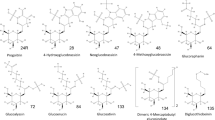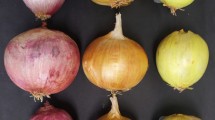Abstract
Onion exhibits wide genetic and environmental variation in bioactive organosulfur compounds that impart pungency and health benefits. A PCR-based molecular marker map that included candidate genes for sulfur assimilation was used to identify genomic regions affecting pungency in the cross 'W202A' × 'Texas Grano 438'. Linkage mapping revealed that genes encoding plastidic ferredoxin-sulfite reductase (SiR) and plastidic ATP sulfurylase (ATPS) are closely linked (1–2 cM) on chromosome 3. Inbred F3 families derived from the F2 population used to construct the genetic map were grown in replicated trials in two environments and bulb pungency was evaluated as pyruvic acid or lachrymatory factor. Broad-sense heritability of pungency was estimated to be 0.78–0.80. QTL analysis revealed significant associations of both pungency and bulb soluble solids content with marker intervals on chromosomes 3 and 5, which have previously been reported to condition pleiotropic effects on bulb carbohydrate composition. Highly significant associations (LOD 3.7–8.7) were observed between ATPS and SiR Loci and bulb pungency but not with bulb solids content. This association was confirmed in two larger, independently derived F2 families from the same cross. Single-locus models suggested that the partially dominant locus associated with these candidate genes controls 30–50% of genetic variation in pungency in these pedigrees. These markers may provide a practical means to select for lower pungency without correlated selection for lowered solids.


Similar content being viewed by others
Abbreviations
- EPA:
-
Enzymatically produced pyruvic acid
- SSC:
-
Soluble solids content
- SSCP:
-
Single-stranded conformation polymorphism
- HDX:
-
Heteroduplex
- LF:
-
Onion lachrymatory factor
- CAPS:
-
Cleaved amplified polymorphic sequence
- ACSO:
-
Alk(en)yl cysteine sulfoxide
References
Ali M, Bordia T, Mustafa T (1999) Effect of raw versus boiled aqueous extract of garlic and onion on platelet aggregation. Prostaglandins Leukot Essent Fatty Acids 60:43–47
Block E (1992) The organosulfur chemistry of the genus Allium—implications for the organic chemistry of sulfur. Agnew Chem Int Ed Engl 31:1135–1178
Crowther T, Collin HA, Smith B, Tomsett AB, O’Connor D, Jones MG (2005) Assessment of the flavour of fresh uncooked onions by taste-panels and analysis of flavour precursors, pyruvate and sugars. J Sci Food Agric 85:112–120
Freeman GG, Mossadeghi N (1970) Effect of sulphate nutrition on flavour components of onion (Allium cepa). J Sci Food Agric 21:610–615
Galmarini CR, Goldman IL, Havey MJ (2001) Genetic analyses of correlated solids, flavor, and health-enhancing traits in onion (Allium cepa L.). Mol Genet Genomics 265:543–551
Griffiths G, Trueman L, Crowther T, Thomas B, Smith B (2002) Onions-a global benefit to health. Phytother Res 16:603–615
Imai S, Tsuge N, Tomotake M, Nagatome Y, Sawada H, Nagata T, Kumagai H (2002) Plant biochemistry: an onion enzyme that makes the eyes water. Nature 419:685
Kuhl JC, Cheung F, Yuan Q, Martin W, Zewdie Y, McCallum J, Catanach A, Rutherford P, Sink KC, Jenderek M, Prince JP, Town CD, Havey MJ (2004) A unique set of 11,008 onion expressed sequence tags reveals expressed sequence and genomic differences between the monocot orders Asparagales and Poales. Plant Cell 16:114–125
Kyung KH, Lee YC (2001) Antimicrobial activities of sulfur compounds derived from S-alk(en)yl-L-cysteine sulfoxides in Allium and Brassica. Food Rev Int 17:183–198
Leustek T, Martin MN, Bick JA, Davies JP (2000) Pathways and regulation of sulfur metabolism revealed through molecular and genetic studies. Annu Rev Plant Physiol Plant Mol Biol 51:141–165
Lin M, Watson JF, Baggett JR (1995) Inheritance of soluble solids and pyruvic acid content of bulb onions. J Am Soc Hortic Sci 120:119–122
Martin W, McCallum J, Shigyo M, Jakse J, Kuhl J, Yamane N, Pither-Joyce M, Gokce A, Sink K, Town C, Havey M (2005) Genetic mapping of expressed sequences in onion and in silico comparisons with rice show scant colinearity. Mol Genet Genomics 274:197–204
McCallum JA, Grant DG, McCartney EP, Scheffer J, Shaw ML, Butler RC (2001a) Genotypic and environmental variation in bulb composition of New Zealand adapted onion (Allium cepa) germplasm. N Z J Crop Hortic Sci 29:149–158
McCallum JA, Leite D, Pither-Joyce MD, Havey MJ (2001b) Expressed sequence markers for genetic analysis of bulb onion (Allium cepa. L.). Theor Appl Genet 103:979–991
McCallum JA, Pither-Joyce MD, Shaw ML (2002) Sulfur deprivation and genotype affect gene expression and metabolism of onion roots. J Am Soc Hortic Sci 127:583–589
McCallum J, Porter N, Searle B, Shaw M, Bettjeman B, McManus M (2005) Sulfur and nitrogen fertility affects flavour of field-grown onions. Plant Soil 274:151–158
McCallum J, Clarke A, Pither-Joyce M, Shaw M, Butler R, Brash D, Scheffer J, Sims I, van Heusden S, Shigyo M, Havey M (2006) Genetic mapping of a major gene affecting onion bulb fructan content. Theor Appl Genet 112:958–967
McManus MT, Leung S, Lambert A, Scott RW, Pither-Joyce M, Chen B, McCallum J (2005) Molecular and biochemical characterisation of a serine acetyltransferase of onion, Allium cepa (L.). Phytochemistry 66:1407–1416
Payne RW, Baird DB, Cherry M, Gilmour AR, Harding SA, Kane AF, Lane PW, Murray DA, Soutar DM, Thompson R, Todd AD, Tunnicliffe Wilson G, Webster R, Welham SJ (2005) GenStat 8.2. Lawes Agricultural Trust
Randle WM (1992) Onion germplasm interacts with sulfur fertility for plant sulfur utilization and bulb pungency. Euphytica 59:151–156
Randle WM (2000) Increasing nitrogen concentration in hydroponic solutions affects onion flavor and bulb quality. J Am Soc Hortic Sci 125:254–259
Randle WM, Lancaster JE (2002) Sulphur compounds in Alliums in relation to flavour quality. In: Rabinowitch H, Currah L (eds) Allium crop science—Recent advances. CABI Publishing, Oxford, pp 1–62
Randle WM, Kopsell DE, Kopsell DA, Snyder RL (1999) Total sulfur and sulfate accumulation in onion is affected by sulfur fertility. J Plant Nutr 22:45–51
Rendu F, Brohard-Bohn B, Pain S, Bachelot-Loza C, Auger J (2001) Thiosulfinates inhibit platelet aggregation and microparticle shedding at a calpain-dependent step. Thromb Haemost 86:1284–1291
Ricroch A, Yockteng R, Brown SC, Nadot S (2005) Evolution of genome size across some cultivated Allium species. Genome 48:511–520
Rose P, Whiteman M, Moore PK, Zhu YZ (2005) Bioactive S-alk(en)yl cysteine sulfoxide metabolites in the genus Allium: the chemistry of potential therapeutic agents. Nat Prod Rep 22:351–368
Schmidt NE, Santiago LM, Eason HD, Dafford KA, Grooms CA, Link TE, Manning DT, Cooper SD, Keith RC, Chance WO, Walla MD, Cotham WE (1996) Rapid extraction method of quantitating the lachrymatory factor of onion using gas chromatography. J Agric Food Chem 44:2690–2693
Schwimmer S, Guadagni D (1962) Relation between olefactory threshold concentration and pyruvic acid content of onion juice. J Food Sci 27:94–97
Schwimmer S, Weston WJ (1961) Enzymatic development of pyruvic acid in onion as a measure of pungency. J Agric Food Chem 9:301–304
Simon PW (1995) Genetic analysis of pungency and soluble solids in long-storage onions. Euphytica 82:1–8
Sinclair PJ, Blakeney AB, Barlow EWR (1995) Relationships between bulb dry matter content, soluble solids concentration and non-structural carbohydrate composition in the onion (Allium cepa). J Sci Food Agric 69:203–209
Wall MM, Mohammad A, Corgan JN (1996) Heritability estimates and response to selection for the pungency and single center traits in onion. Euphytica 87:133–139
Acknowledgments
We acknowledge significant contributions of the following: Bodhi Bettjeman, Paul McCartney and Winston Fahey for technical support; David and Judy MacMillan and Enza Zaden NZ Ltd for field trial support. This work was funded by the New Zealand Foundation for Research, Science and Technology.
Author information
Authors and Affiliations
Corresponding author
Additional information
Communicated by C. F. Quiros.
Rights and permissions
About this article
Cite this article
McCallum, J., Pither-Joyce, M., Shaw, M. et al. Genetic mapping of sulfur assimilation genes reveals a QTL for onion bulb pungency. Theor Appl Genet 114, 815–822 (2007). https://doi.org/10.1007/s00122-006-0479-8
Received:
Accepted:
Published:
Issue Date:
DOI: https://doi.org/10.1007/s00122-006-0479-8




